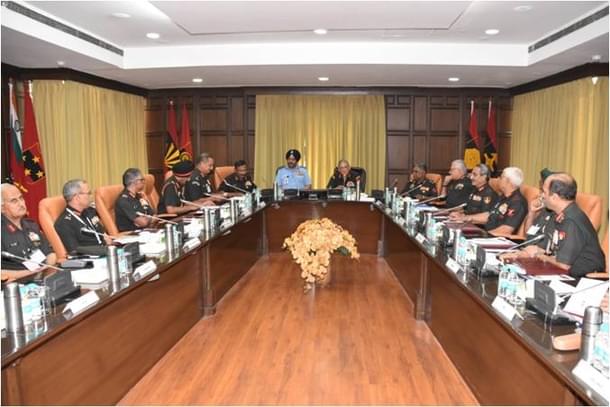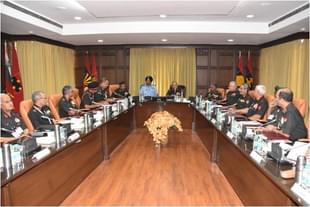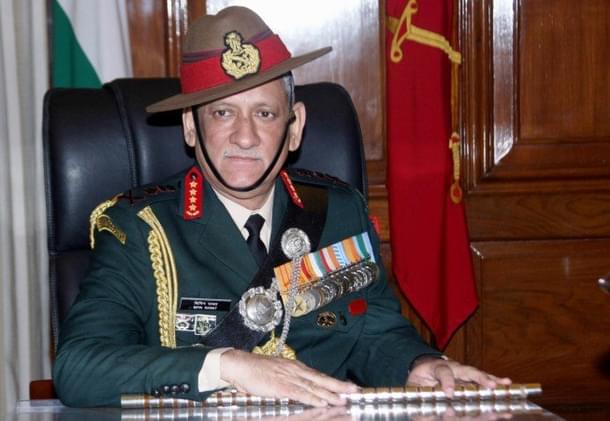Defence
Military Top Brass Meets In Srinagar, Triggers Panic In Pakistan
Nitin A. Gokhale
Jun 06, 2017, 11:20 PM | Updated 11:20 PM IST
Save & read from anywhere!
Bookmark stories for easy access on any device or the Swarajya app.


The meeting triggered frantic reactions on that side of the border.
The two-day conclave of the Indian Army top brass last week, held in Jammu and Kashmir’s capital Srinagar, has initiated a five-year road map for India’s land forces.
The brainstorming session, spread over two full days on Friday and Saturday also generated alarm and bit of panic across the Line of Control (LoC) in Pakistan since it was attended by the Army Chief, all the seven Army Commanders, CISC (head of Integrated Defence Staff) and the Director Generals of Army, Air Force and Naval Operations besides select Corps Commanders.
Not sure of the purpose and outcome of the unusual and high-level meeting, Pakistan activated all its radars along the border and cancelled leave for all its troops under 12 and 23 Divisions besides those under the Force Commander Northern Areas (FCNA), Indian intelligence reports said. The Pakistan Air Force also put its frontline bases on operational readiness, the reports added.
Monday’s unscheduled telephonic conversation between the Indian and Pakistani Director Generals of Military Operations (DGsMO)—at Pakistan’s request—would have however reassured Pakistan that India was not initiating any aggressive move along the LoC, top sources said. The Indian DGMO, who was also part of the Srinagar Conclave, assured his counterpart that India was committed to ensuring peace and tranquillity along the LoC. But, the Indian DGMO also warned, “If Pak Army continues to abet infiltration and cause trans-LoC firings, Indian Army will take appropriate retaliatory actions.” The DGMO’s clear warning is in keeping with the Indian army’s recent aggressive posture along the LoC.
However, the purpose of the top brass’ conclave, according to multiple participants, was not to look at the current scenario but to chalk out strategies for two or three main challenges that the Indian military, especially the Indian Army, is likely to face in the near future. While the challenges are self-evident—China, Pakistan and their increasing collusion—tactics and strategies to deal with them are not.

Army Chief Gen Bipin Rawat, a great believer in building consensus and drawing upon the collective wisdom of his top commanders, hit upon the idea to get the brass together to pick their brains in a non-formal atmosphere. The formal and structured Army Commanders Conference, held twice a year in Delhi, has many administrative, personnel and welfare issues to be discussed and decided, leaving very little time for the top commanders to concentrate on evolving medium- to long-term war strategies.
The Srinagar Conclave, therefore, had only one agenda: come up with a coherent, effective plan to deal with the existing and future challenges. Managing the LoC, India’s posture along the International Border in Punjab and Rajasthan, deployment and employment of Indian armour and optimum use of Special Forces for strategic operations were among the broad topics discussed, highly placed sources said.
The Army Commanders agreed that Pakistan is unlikely to stop its proxy war in Jammu and Kashmir in the near future. They also noted that since 2013 the highly-trained and well-armed terrorists were told to specifically target security forces in order to provoke India into a hasty reaction.
A surfeit of attacks on military garrisons, convoys and outposts—Uri, Nagrota, Samba, Mohora gun position incidents, Hyderpora attack on Army convoy and even Monday’s suicide attack on the Central Reserve Police Force (CRPF) camp in Bandipora are only a few examples—provide ample proof of that changed tactics. So the brass discussed ways to prevent such attacks and minimise casualties besides deliberating upon options for counter-attacks and employing different pressure points on the LoC.
The top commanders also gazed into the crystal ball to discern likely Chinese moves along the Line of Actual Control (LAC) and in Gilgit-Baltistan. According to participants in the conclave, it was decided to speed up the infrastructure projects along the LAC and also tweak deployment of forces. After having inserted a regiment of tanks in Ladakh in 2013, moves are afoot to increase the armour strength in high altitude areas. Raising of one more mountain division for the Mountain Strike Corps is already under way. The timeline for raising the full strength 17 Mountain Corps has now been tweaked to align with more realistic targets, sources said.
While many new suggestions came up during the brainstorming session, the brass felt it needed at least one more similar sitting to firm up different counter-strategies for the myriad challenges they have envisaged.
This post was first published on BharatShakti and has been republished here with permission.
Image credits: Air Chief Marshal and Army Commanders meeting in April (Twitter.com/@adgpi)
An authoritative defence analyst, media trainer and a multi-media reporter who started his career in 1983, Gokhale has worked across web, print and broadcast mediums over the last three decades. He has a rare distinction of living and reporting from India’s North-eastern region for 23 years.





